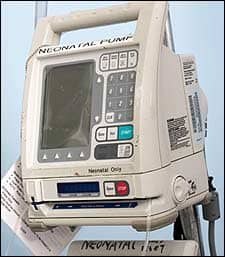By Caitlin S. Young
As a new student intern in the clinical engineering department at Eastern Maine Medical Center (EMMC), I was immersed in a world of terminology, technology, and regulation to which I had never previously been exposed. Wanting to be of real use to my employer, I knew that I would have to establish some familiarity with my environment. I began asking questions—and plenty of them—on day one.
Right away, I discovered that what I thought something meant, or how I thought something worked (whether it be a medical device or a regulatory body) often differed from the facts. Sometimes, these discrepancies had significant implications. The ability to define a term like “invasive procedure” in an approximate way serves most applications, but it is not sufficient to inform discourse or decision-making about the various risks and equipment involved. How do regulatory bodies define “invasive?” Are colonoscopies considered invasive? Gynecological exams? Skin biopsies, blood sampling, throat cultures?
Asking, “What does this mean?” became a matter of habit. I took initiative to answer the question for myself whenever possible, conducting research and investigations, in addition to consulting with those around me. It pays to be curious. What I uncovered invariably taught me more than I had set out to discover. Still, as the weeks passed and my work increased in complexity, the question became more challenging to answer.
At the time of my arrival, EMMC was interested in reworking and formalizing a streamlined maintenance plan-determination strategy for its medical devices. Moving forward, this policy would be used to systematically evaluate and document failure rate, risk level, AEM maintenance plan eligibility, and manufacturer support for each device type—nearly 600 different categories encompassing 31,000 devices—within Eastern Maine Healthcare Systems (EMHS).
Maximizing process efficiency was a major objective. After all, it does not make sense to spend hours evaluating the maintenance strategy for a thermometer with the same rigor and intensity as that of a high-risk or critical-care device. Why chase after obscure data if the information is unlikely to influence maintenance strategy outcomes? The final policy had to be more or less self-explanatory, progressing in a logical manner while providing enough information to guide a qualified person through it from start to finish, even if they had never seen it before.
At first, I was simply tasked with revising the checklist used for assessing the risk category of a device (high, medium, low). However, one cannot form a complete picture of risk without considering the failure rate associated with a device type—so, after some additional research, I wrote a formal failure rate calculation procedure to accompany the risk assessment form.
But the process didn’t end there. As it turns out, one cannot calculate an accurate failure rate without first collecting and documenting some maintenance history. I learned that devices with “insufficient maintenance history” are always ineligible for AEM strategies, according to the Joint Commission.
“Insufficient maintenance history?” What does this mean? Suddenly, I had stumbled upon a question for which no exact or universally applicable answer exists. I decided to put forth my best effort to find one that would function well at EMMC. What does this really mean for us? How can we establish the best possible maintenance history for the greatest number of AEM-eligible medical devices in a reasonable amount of time?
Since then, I have invested a considerable amount of effort in the development of a comprehensive maintenance planning and documentation strategy for EMMC. The final product is 12 pages long: six forms, including a final “decision tree” summary, plus six pages of guidance, background information, and key terms.
Despite its apparent bulk, it is designed to help the user reach an informed and documented conclusion with maximum efficiency. Not every device will require the use of all included forms. Rather, these are provided as additional tools, intended to assist with devices that are difficult to categorize, or which can only be managed with an AEM strategy if there is substantial documentation to justify the decision.
To date, every application of this new procedure has proven it to be functional and versatile—it has been deemed a success. I learned a tremendous amount from this process, and am gratified as a student and an intern to feel a sense of lasting contribution. Of course, I would not have gotten far without an incredible amount of support, encouragement, and engagement from my supervisors, who allowed me to work frequently on those projects with which I was most interested, who fed me reading material and offered feedback, and whose decades of experience I relied on and drew from heavily.
As a fresh pair of eyes in the HTM field, I feel that I may have had a slight (and surprising) advantage in this work. There is considerable complexity and responsibility inherent in the determination of maintenance strategies. The stakes can be high, and there are uncomfortable grey areas. Sorting them out takes time. As a student and a beginner, I was able to break a massive process into tiny steps precisely because I could not see any further down the road than where I happened to be standing. I had less on my plate, too, than the busy professionals working around me.
Through it all I made no assumptions, instead letting curiosity and a simple question—what does this mean?—be my guide. In finding answers for myself, I was able to help the EMMC team.
Caitlin Young is a nontraditional senior student in the biomedical engineering bachelor’s degree program at the University of Maine and a recent alumnus of the clinical engineering co-op program at Eastern Maine Medical Center in Bangor. For more information, contact 24×7 Magazine chief editor Keri Forsythe-Stephens at [email protected].







Congratulations Caitlin for your initiative. Students should do this. Ask, ask and ask. If there is no answer that suits you, search for them yourself. Keep writing, we really need to write to the other colleagues in our very cool area of work.
Thank you! Your encouragement, as well as the support of this magazine and my employer, means a lot!!
Thank you for your supportive words!
Bravo! Caitlin, you did a great job in questioning old traditions, many of which are myths and misconceptions. For example, the so-called risk classification is actually severity classification (https://24x7mag.com/2011/08/are-you-managing-risk-or-severity-2/) since it did not consider probability (failure rate). “Insufficient maintenance history” is another good example. Without a few dozen data points, it is statistically meaningless to calculate average or standard deviation. This was the reason that I said Evidence-Based Maintenance (EBM) is not easy (https://24x7mag.com/2016/04/evidence-based-maintenance-ces-moonshot/) and we must work together to gather enough data to make sound decisions. Collectively we have gathered >30 years of data without analyzing them and, thus, struggled to produce objective evidence to prove to FDA and OEMs that we are doing an incredibly good and safe job. I hope other young professionals follow your example in applying not only engineering skills but especially critical thinking to take our profession to the next level. Otherwise, we will remain simply a craft that has little recognition and support from our healthcare colleagues and executives.
Bravo! Caitlin, you did a great job in questioning old traditions, many of which are myths and misconceptions. For example, the so-called risk classification is actually severity classification (https://24x7mag.com/2011/08/are-you-managing-risk-or-severity-2/) since it did not consider probability (failure rate). “Insufficient maintenance history” is another good example. Without a few dozen data points, it is statistically meaningless to calculate average or standard deviation. This was the reason that I said Evidence-Based Maintenance (EBM) is not easy (https://24x7mag.com/2016/04/evidence-based-maintenance-ces-moonshot/) and we must work together to gather enough data to make sound decisions. Collectively we have gathered >30 years of data without analyzing them and, thus, struggled to produce objective evidence to prove to FDA and OEMs that we are doing an incredibly good and safe job. I hope other young professionals follow your example in applying not only engineering skills but especially critical thinking to take our profession to the next level. Otherwise, we will remain simply a craft that has little recognition and support from our healthcare colleagues and executives. I also hope to see your work published soon.
Thank you! It is encouraging to hear that I did not miss the mark, especially being so new. I think sorting out these nuances is actually quite interesting and important!